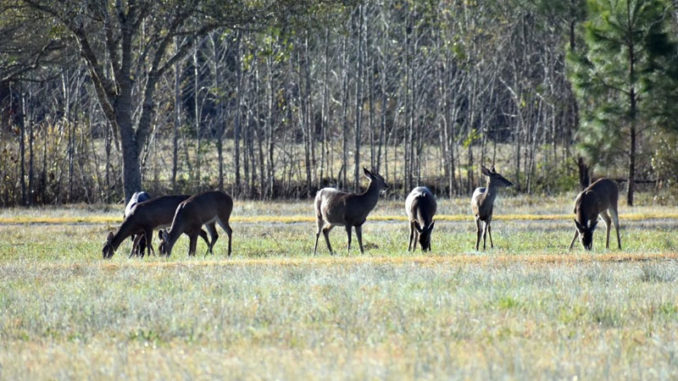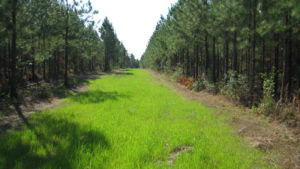
Cereal grains can bring deer to your food plot
Over half the deer season is behind us, and the deer population in the Carolinas is much smaller than it once was back during August. But the season is long from being over.
Ample time remains for hunters to devise another strategy to scratch off a hit-list buck before Jan. 1. The combination of cooler weather and limited natural food sources makes cover crops on nearby agriculture fields a solid choice for a stand setup.
As the fall season ripens, the rut is far from over; bucks are on the prowl. Solid food sources turn into Grand Central Station in deer country. Acorns and other natural foods are becoming scarce, and lush greenery is a thing of the past. In agriculture areas, the fields of corn, peanuts, sweet potatoes and soybeans are picked clean. And few residual food stores are left to supply deer and other wildlife through fall and early winter.
Most farmers plant cover crops to prevent erosion, retain soil moisture, and to provide a thick mat of vegetation to combat the spring weed invasion. These cover crops are often made of cereal grains, including wheat, rye and triticale. These crops are cold-weather tolerant and are perfect opportunities to sustain during the winter. Deer, turkey and other wildlife species are crazy about these cereal grains. And a winter source of these grains is a prayer answered.
Immediate impacts
Fortunately, these crops are appealing immediately after they break the soil’s surface. It’s like candy for deer and other wildlife, and these tender, green shoots are not only tasty, they are loaded with nutrition.
Deer and other wildlife will find these nutrient stores within days of arrival, and these animals will center their daily routines around these fields.
In the Carolinas, cover crops typically get sowed into the fields in late October and November, but they could be planted into December in some areas, depending on the previous crop and past weather conditions. Look for recent disking, and watch for those blackish-brown fields to transform into a green hue after the tender rye or wheat begin to erupt through the soil’s surface.
To get a jump on the herd movement, hunters can coordinate with their local farmer to see which fields will be getting a cover crop. Then, they can prepare their stands along the field edges or major travel corridors leading to and from these fields before the crops get into the ground.
Regardless, cover crops are target areas for deer and other species of wildlife during the late fall and winter months. With a solid food source available in these areas for the last half of the deer season, hunters can surely fill their last few deer tags.

Even the smallest of food plots, including this narrow shooting lane, can play host to a nice, late-fall planting of cereal rye, which will draw hungry deer.
Plant cereal rye right now
Not every hunting property features agriculture fields loaded with crops deer and other wildlife love.
If not, plant it, and they will come.
The fall food-plot planting season begins in September and is typically over by the middle of October — certainly by the end of October. But deer and other wildlife will flock to a field of cereal rye, even when planted as late as November, especially in areas with limited food resources. Cereal rye is a good, late-season choice for a food plot that will draw in the deer.
Cereal rye can produce as much as 25% usable crude protein, and it’s quite tasty; it will bring deer in to munch daily. Luckily, rye is also resistant to heavy browsing and will readily re-sprout, providing a consistent, tender food source for the rest of the season.
Cereal rye isn’t a new plant in the farming community. It originated in southwestern Asia and was imported to America in the 17th century by English and Dutch settlers. Rye is a small-seeded grain that is more tolerant of frost and drought than just about any other grain available, including wheat and oats.
Rye can be grown just about anywhere and in almost any soil type, including the clay-rich lands of the Carolinas’ piedmont and the dry, sandy soils of the sandhills. Not only does it tolerate dry, sandy soils, it will thrive in these normally poor soil conditions. Additionally, rye tolerates higher-than-normal soil acidity than wheat, its distant cousin.
Rye is the most cold-tolerant cereal grain during germination and through its growth cycle. Most grass seeds germinate in temperatures between 50 and 70 degrees; rye can germinate during periods of 33-degree weather, and a well-established stand can withstand temperatures well below freezing for long periods of time. However, growth and re-growth from foraging will be slow in consistent temperatures near and below freezing. But in the Carolinas, consistent temperatures near and below freezing for long periods of time are few and far between in November and December.
One of the best aspects of planting rye is that it doesn’t take a lot of specialized farming equipment to get a stand off the ground. A disk and a spreader are all that is normally required.
For the best results, a trifecta of nitrogen, phosphorus and potassium should be applied at the time of planting in areas with a soil pH greater than 5.0. Forty to 50 pounds per acre of each should be applied for the best results. Rye should be broadcast-seeded at a rate of 140 to 150 pounds per acre right after or right before rainfall events to ensure the seeds and young seedlings get adequate moisture. Plants can withstand drought conditions only after the root systems develop deep into the soil strata. Prior to that, young plants need adequate moisture to survive.
Rye is a perfect late-season crop to establish on large food plots and even in shooting lanes only 20 feet wide, extending from a favorite tower stand. Deer love it, and it will quickly re-sprout after heavy use.




Be the first to comment